
Paris Opera Ballet
Manon (L’histoire de Manon)
Paris, Palais Garnier
25 April, 3 and 5 May 2012
www.operadeparis.fr
I had the good fortune to attend three performances of Manon during the Paris Opéra Ballet’s recent run in April/May 2012. Last-minute changes meant I missed both Agnes Létestu and Ludmila Pagliero as Manon (neither of them ended up performing the role at all, I believe). However, I’m very satisfied with the performances I saw: one by Aurélie Dupont/Josua Hoffalt and two by Isabelle Ciaravola/Mathieu Ganio.
As Manon, Dupont started out as sweet and innocent. Overall, her Manon seemed almost empty, like a vessel for people to put eroticism into or to act upon. In act two, she made the bracelet Monsieur GM gives her a focal point, continually touching it and looking down at it, while waiting to dance. Of course part of this is due to the choreography, which requires Manon to react to her jewels – but Dupont paid exceptional attention to the bracelet. The bracelet became like a jailer’s cuff, foreshadowing the very different and unwelcome action in act three.
Upon reflection, Dupont’s interpretation becomes more and more interesting. The choreography requires Monsieur GM, Lescaut, and the jailor all to turn Manon’s face to gaze upon their own. What was a touch or caress by male characters in the other casts became dragging and pulling in this one. Dupont’s Manon made them work for her gaze, for her face. Each time her head was heavy and reluctant. She seemed to have her sexuality drawn out of her, almost against her will. The exception – the act one bedroom pas de deux with Des Grieux – was short-lived. Had Manon stayed with him, how different her life could have been. Here, it seemed, was the happiness she could have had. In act two, when that other life appeared gone, she became cold and hard in her black dress, glittering like Odile. She seduced because she had to, not because she wanted to.
In contrast, Ciaravola’s Manon (especially in the first of the two portrayals I caught) was a coquette. Her shoulders shimmied from the start; she walked flirtatiously and was immediately intrigued by the whores’ lifestyle. While she liked the gems Monsieur GM gave her, she liked the attention too. Her act two dance with all the gentlemen callers almost evoked a perverse Rose Adagio, an uneven grouping in which each man hoped to hold on to her. In contrast, when Dupont performed the same scene, I had the uncomfortable feeling of watching what almost amounted to assault. Dupont’s performance revealed manipulation of a woman’s body by men; Ciaravola’s, a kind of triumph.
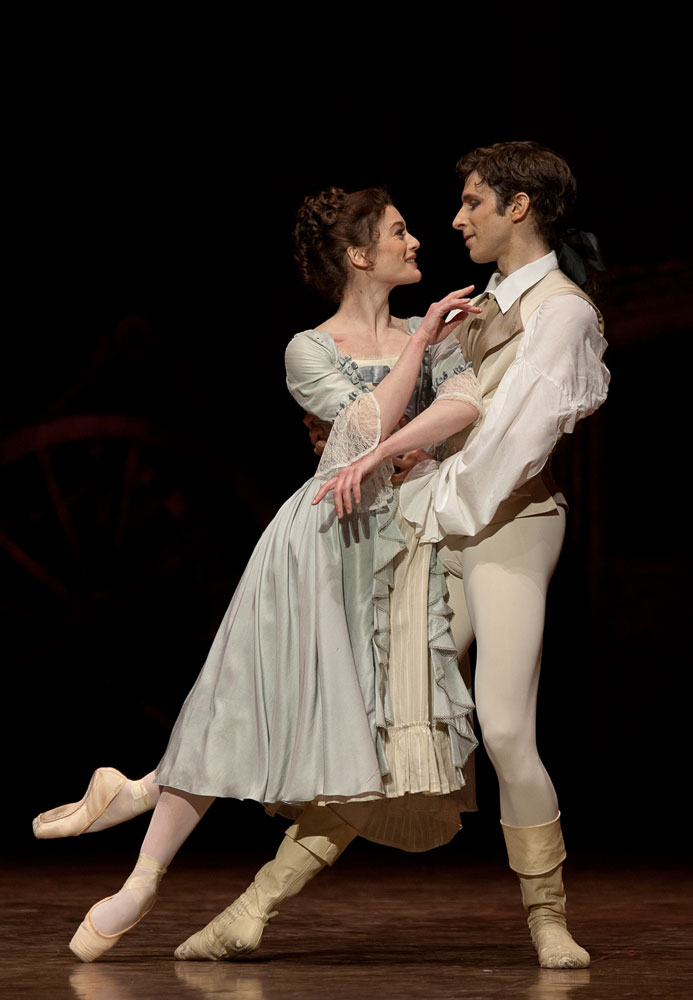
When Dupont performed, I kept thinking about how Manon backs away from all the male characters in rapid sets of bourrées – she even moves away from Des Grieux – as though on some level she doesn’t consent or doesn’t want to be touched. When Ciaravola performed the role, this step became more of a coquettish trick – as though she were saying, “Can you catch me?” – as well as an indication of hesitation or doubt.
Perhaps the single most beautiful moment in all the performances came from the smallest of steps Ciaravola executed during the act one bedroom pas de deux. Forgive me while I drop into full ballet speak: Standing in an open tendu derrière, her torso pointing away from Des Grieux and her toes reaching to him, she slowly revolved back to him, resting for a moment in tendu devant before deliberately rolling through her front foot and coming into tendu derrière once more. This slow-motion version of the simplest classroom step had such uncanny beauty. It certainly took my breath away. The next time I saw Ciaravola, I looked forward to this moment, but the clarity and deliberation I had found so moving the first time were missing from the step. She went from beautiful tendu to beautiful tendu, but this time faster, with less precision – almost as if she were in a hurry to return to her Des Grieux.
Overall, I preferred Mathieu Ganio to Josua Hoffalt as Des Grieux. Hoffalt seemed slightly less smooth in his movement quality; Ganio (especially the first night I saw him) revealed a creamy plié and a high arabesque. He gave such a smooth rendering of the act one solo, showing off his liquid lines, that it was easy to see why Manon falls for him. Ganio also made Des Grieux’s dramatic choices seem credible, spinning in disbelief to find Manon gone from his rooms, rushing up against the jailer’s restraining arms. When Hoffalt performed, I wondered why he let Lescaut grab him and force the coins into his hand at the end of act one; why he didn’t run after Manon right away in act three, when the jailer’s minions snag her. Hoffalt’s Des Grieux seemed more innocent and naïve, not sure what he should or could do to hold on to this woman he’d encountered. With him, you understood that the plan to cheat Monsieur GM would never work: how could he possibly be successful in cheating at cards? Ganio made you understand too, in a different way: this Des Grieux is so caught up in love he loses sight of his better judgment.
These casts fielded three excellent Lescauts. Jérémie Bélingard was the wildest, a man who plays hard and doesn’t care about the results, and the most reckless, in characterization and in the wildness of his steps. He and Stéphane Bullion, who was charismatic, powerful, and present, both played the drunken act two pas de deux for laughs. Of the three, Bullion made Lescaut seem most at fault for bringing his sister to ruin. Yann Saïz started out as the weakest – this is not to say that his dancing was weak but that his Lescaut was. At first, I preferred Bullion’s characterization. However, as act two went on, Saïz’ interpretation of Lescaut as a weak man made increasing sense. His drunken pas de deux was played with a poker face: he was so committed to the dead man falls and so serious in attempting to carry out his duties as a cavalier. It was no wonder he made such fatal mistakes at the card table, and impossible not to feel sorry for him.
While Alice Renavand, Muriel Zusperreguy, and Nolwenn Daniel all tackled the role of Lescaut’s Mistress with gusto and energy, I found Daniel the most memorable of the three: coquettish, appealing, hard to ignore. With her fine technique and strong stage presence, she has the potential to be a wonderful Manon herself, I think.
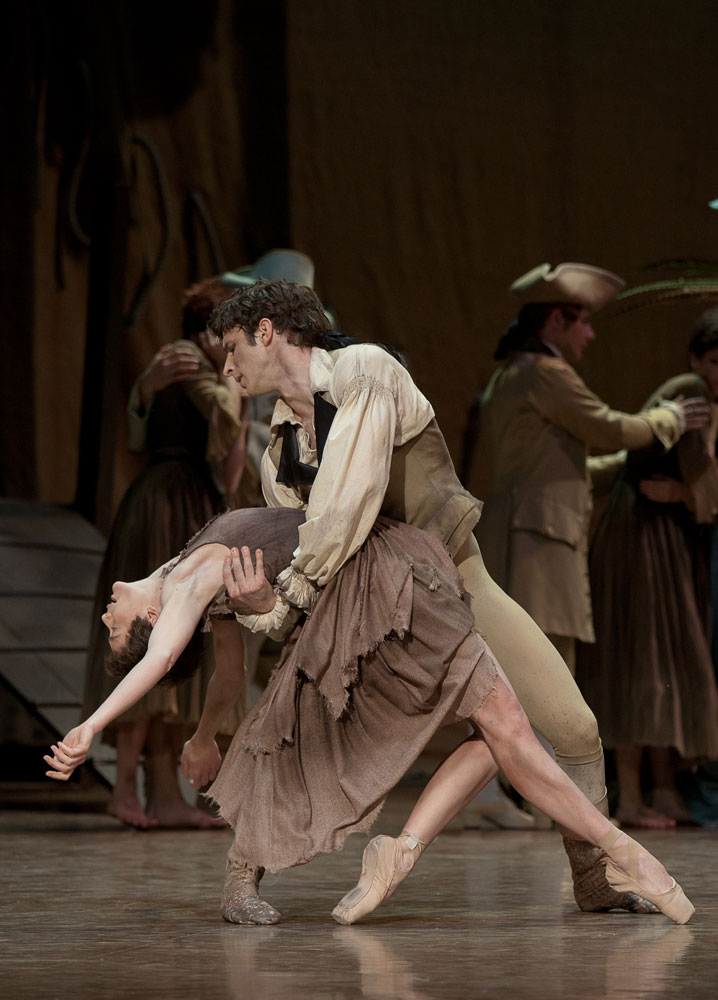
All three jailors – Vincent Cordier, Mathieu Botto, and Aurélien Houette – were excellent, foreboding, and terrible. Each seemed as though he could crush his Manon. Houette, perhaps the most powerful and frightening of the three, also gave the most haughty and weighted rendering of Monsieur GM I saw (the other GMs were Éric Monin and Stéphane Phavorin, both very good). Casting the same dancer as Monsieur GM and the jailer, albeit in different performances, is a fascinating dramatic tidbit that underscores the connections between these two powerful men – they both take advantage of Manon, they both try to buy her affections with jewelry, and they both try to steal her from the man she really loves. How different are they, really?
By the third performance, some of the dancers seemed to be flagging a little, and mishaps occurred with both costumes and props. (Kudos to the quick-thinking Monin, whose Monsieur GM stepped carefully on a trailing piece of tulle during the act one pas de trois and averted a further costuming mishap while remaining in courtly character.) Yet the stage is so full of minute, continually changing pieces of characterization it’s hard to know where to look when. In act one, do you watch Lescaut’s mistress perform and reveal her wares, or do you watch Manon, sitting on a chair upstage, taking in all the action for the first time too? When Madame matches up her whores with various gentlemen, which mini-drama will you catch? It’s impossible to take in the entire spectrum. Manon is a rich ballet that rewards repeated viewing; seeing these three performances just left me wanting more. Here’s hoping Manon shows up again in the POB’s repertoire, and soon.









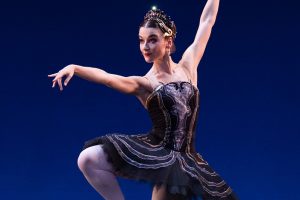



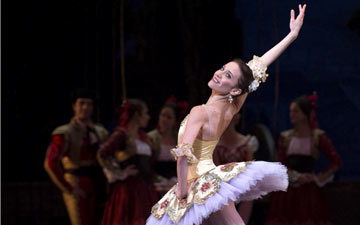

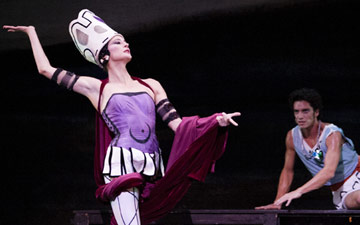

I saw the performance on the 25th with Aurelie Dupont and Josua Hoffalt, Muriel Zusperreguy, Jeremie Belingard. I t was very much as I remembered the original for The Royal Ballet when choreographed by Sir Kenneth. I was actullay working with the company at the time and have always loved the production..
Whilst the POB danced the wonderful complicated sequences extremely well, it did not quite retain the original charisma. For instance the potrayal of Lescaut’s Mistress had lost a lot of it’s “Bawdy” element, it was too refined too polite.
At Madame’s house party there is a virtuioso Pas de troisfor three boys, which I am sorry to say just did not work. It is supposed to be crisp, in complete unison, and a spectacular variation. The dancers I saw were out of time, line and did not make a very good job of it at all., which is a pity as it is a very entertaining variation if danced well.
I liked Aurelie Dupont’s Manon, though in the final Pas de deux she was much too fit, and should not have had the energy to run to Des Grieux as she did.
Jeremie Belingard was excellent in the role of Lascaut, playing the evil brother to it’s full potential, and dancing the drunk scene in an amusing but not over stated manner.
And last but not least Josua Hoffalt, played the love sick Des Grieux as a slightly naive young man, head over heels in love, and not quite understanding how to compete with the rich and older competition for Manon’s affections. His dancing seems to have gone from strength to strength since I saw him in La Source,last year. He makes a good partner for Aurelie Dupont, and there certainly seems to be chemistry between them. It seems a shame that there is such a large gap in their career’s, Aurelie at the end of hers, and Josua just starting as an Etoile. However we hopefully will be able to enjoy this partnership as long as possible.